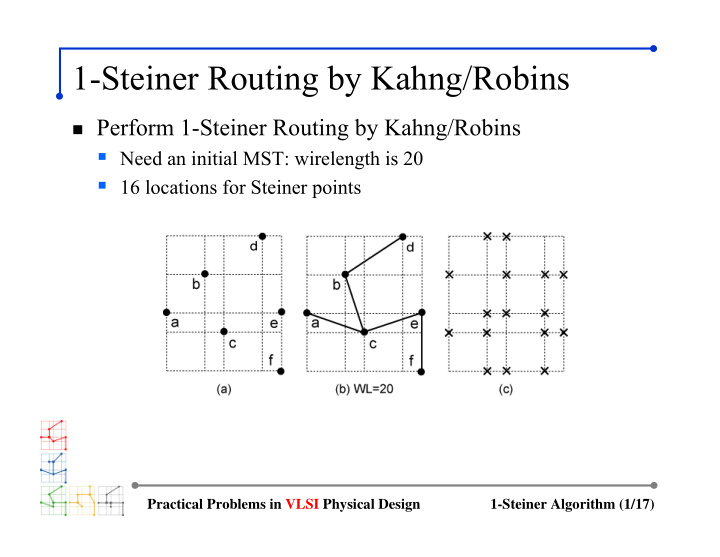



1-Steiner Routing by Kahng/Robins � Perform 1-Steiner Routing by Kahng/Robins � Need an initial MST: wirelength is 20 � 16 locations for Steiner points Practical Problems in VLSI Physical Design 1-Steiner Algorithm (1/17)
First 1-Steiner Point Insertion � There are six 1-Steiner points � Two best solutions: we choose (c) randomly before insertion Practical Problems in VLSI Physical Design 1-Steiner Algorithm (2/17)
First 1-Steiner Point Insertion (cont) before insertion Practical Problems in VLSI Physical Design 1-Steiner Algorithm (3/17)
Second 1-Steiner Point Insertion � Need to break tie again � Note that (a) and (b) do not contain any more 1-Steiner point: so we choose (c) before insertion Practical Problems in VLSI Physical Design 1-Steiner Algorithm (4/17)
Third 1-Steiner Point Insertion � Tree completed: all edges are rectilinearized � Overall wirelength reduction = 20 − 16 = 4 before insertion Practical Problems in VLSI Physical Design 1-Steiner Algorithm (5/17)
1-Steiner Routing by Borah/Owens/Irwin � Perform a single pass of Borah/Owens/Irwin � Initial MST has 5 edges with wirelength of 20 � Need to compute the max-gain (node, edge) pair for each edge in this MST Practical Problems in VLSI Physical Design 1-Steiner Algorithm (6/17)
Best Pair for ( a,c ) Practical Problems in VLSI Physical Design 1-Steiner Algorithm (7/17)
Best Pair for ( b,c ) � Three nodes can pair up with ( b,c ) l ( a,c ) − l ( p,a ) = 4 − 2 Practical Problems in VLSI Physical Design 1-Steiner Algorithm (8/17)
Best Pair for ( b,c ) (cont) � All three pairs have the same gain � Break ties randomly l ( b,d ) − l ( p,d ) = 5 − 4 l ( c,e ) − l ( p,e ) = 4 − 3 Practical Problems in VLSI Physical Design 1-Steiner Algorithm (9/17)
Best Pair for ( b,d ) � Two nodes can pair up with ( b,d ) � both pairs have the same gain l ( b,c ) − l ( p,c ) = 4 − 3 l ( b,c ) − l ( p,e ) = 4 − 3 Practical Problems in VLSI Physical Design 1-Steiner Algorithm (10/17)
Best Pair for ( c,e ) � Three nodes can pair up with ( c,e ) l ( b,c ) − l ( p,b ) = 4 − 3 l ( b,d ) − l ( p,d ) = 5 − 4 Practical Problems in VLSI Physical Design 1-Steiner Algorithm (11/17)
Best Pair for ( c,e ) (cont) l ( e,f ) − l ( p,f ) = 3 − 2 Practical Problems in VLSI Physical Design 1-Steiner Algorithm (12/17)
Best Pair for ( e,f ) � Can merge with c only l ( c,e ) − l ( p,c ) = 4 − 3 Practical Problems in VLSI Physical Design 1-Steiner Algorithm (13/17)
Summary � Max-gain pair table � Sort based on gain value Practical Problems in VLSI Physical Design 1-Steiner Algorithm (14/17)
First 1-Steiner Point Insertion � Choose { b , ( a,c )} (max-gain pair) � Mark e 1 = ( a,c ), e 2 = ( b,c ) � Skip { a , ( b,c )}, { c , ( b,d )}, { b , ( c,e )} since their e 1 / e 2 are already marked � Wirelength reduces from 20 to 18 Practical Problems in VLSI Physical Design 1-Steiner Algorithm (15/17)
Second 1-Steiner Point Insertion � Choose { c , ( e,f )} (last one remaining) � Wirelength reduces from 18 to 17 Practical Problems in VLSI Physical Design 1-Steiner Algorithm (16/17)
Comparison � Kahng/Robins vs Borah/Owens/Irwin � Khang/Robins has better wirelength (16 vs 17) but is slower Practical Problems in VLSI Physical Design 1-Steiner Algorithm (17/17)
Recommend
More recommend